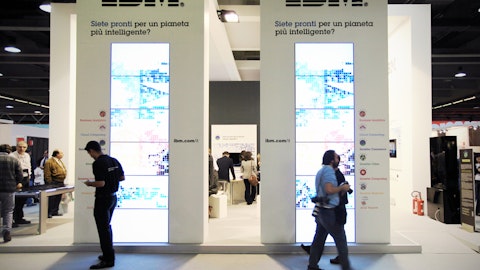Simon Flannery : Great. If I could just stay on the broadband theme, if I could. Perhaps I think you talked perhaps about providing extra color on the financial construct of the BlackRock JV? Are you contributing any capital? Any assets how exactly should we expect that to flow through the financials? And John, on the beat, perhaps you just give us a reflection on the status of the process, the timing, how this is going to play out. I think there’s been a lot of concerns about delays, the mapping process, the challenges and also some of the state broadband offices maybe not being ready to stand this up. So how do you see this evolving? And when do you think you can actually get shovels in the ground to get know what funding been awarded?
And then just finally, getting to 30 million locations is great. What about the prebuilding with fiber with fixed wireless in some of those locations. I think you’ve talked about that. And how does fixed wireless play into some of that other 30 million plus locations that won’t be getting fiber in the near term?
John Stankey : Sure. So Simon, I’ll be — I’ve got to be careful about how much the partnership. It’s a partnership structure, it’s an entirely separate partnership structure, so you shouldn’t expect to see any of the financials pull-through on a balance sheet structure for us, you should expect it to come in is investment income. We’ll give you characterizations of the success of that and as it carries forward and you should think about this as both partners carrying equal weight in the execution of the entity. I think that probably gives you a good enough sense of how it carries through. And if you have something else you want to push on, I can try to give you a little more color. The BEAD timing, my point of view is I think there is — there’s been enough information put out there right now.
We’re going to go through a clarification cycle on the first set of data. I think that’s moving along at a reasonably good cliff right now. And I think, frankly, the bigger states, those that have a more robust staffing capability are being pretty prompt and aggressive in working through getting that data set squared away. I would agree with you that there’s going to be some states that are maybe a little bit slower than others, but my gut is when you’re thinking about kind of the 80-20 rule, the bigger states, they’re going to have the bulk of the funding are pretty zoned in on this, and they’re moving pretty aggressively to get the process underway. And while there may be some smaller states that take a little bit longer to get their act together or are waiting to see how models develop in some of the more lead states that have bigger staffs to consider these things and then kind of be fast followers.
I don’t think that’s going to inhibit some of the more aggressive states and being in the process and us being in a situation where in the third quarter, there’s going to be monies starting to flow down from the Federal government and being turned back to the states for execution. So I don’t think you’re going to see any substantial shovels on the ground and certainly, customers being served in any substantial way this year. But I do think you’re going to see projects and monies awarded before we exit this year, and you will see those volumes start to come online as we move into periods of 2024, and I expect that those will be concentrated in some of the bigger states that have more robust staff that can move through this fairly quickly. And pretty much have a view of how they want to go about doing this.
They’re just trying to get the data to fit into the process. As I’ve said before, we view fixed wireless as being a tool in the toolbox that we can use to deal with opportunities in areas that are less densely populated. We’ll have our next rendition of the product in the market this year. There will be places where we view it as being an acceptable substitute for fiber deployment. They tend to be — they are going to be less densely populated areas where it makes sense to do that. We have a plan as to how we want to test our assumptions around that. We will deploy and take advantage of that. I think it can have an opportunity to help us on some of the long-standing hybrid fiber copper base that we have that maybe has some speed challenges, and it will probably help us manage some of the churn characteristics associated with that, and I would expect to use it in that case.
And then I would also add, look, there’s a lot of businesses that maybe aren’t in those less densely populated areas where this will be a perfectly acceptable and strong product, given the nature of how their business runs and what they need for their daily data needs and service needs. And so I do expect that we’re going to have an opportunity to complement some of our strength in wireless distribution into the business market to provide a more robust fixed broadband alternative, fixed wireless broadband alternative to those customers, and bundle and package it in where it makes sense.
Pascal Desroches : Simon, one other point on the capital structure for the JV to consider is that we do expect it to carry a meaningful amount of debt funding as well.
Simon Flannery : Okay. Great. And are you contributing anything to it? Any capital, any assets? Yes.
John Stankey : We have contributed some into the partnership. The reason you’re going to see it get off the ground as quickly as it will and bring its first customers on in relatively short orders because while we have been structuring and negotiating this, we’ve been doing a fair amount of work in parallel quietly. And so the partnership, as we’ve indicated, is already structured with the management team that’s in place that has been doing a lot of work on the offer that knows the markets we’re going to be in that has infrastructure and system setup that they can be ready to go on. And I think this is probably one of the things our partner found attractive about this. It’s a first-class management team with a lot of capabilities behind it, and we will take some credit for the contribution of that work that we’ve done within the scope of this year.
Operator: And our next question comes from the line of David Barden with Bank of America.
David Barden : I guess first, I just wanted to go back to the notion of wireless postpaid phone market “normalizing.” I think a lot of people look at the relatively high correlation between the substantial step-up that we’ve had in the industry to roughly 9 million postpaid phone nets a year for the last couple of years and AT&T’s kind of resuscitated growth, as John pointed out, over the last 10 quarters. And as such, when people consider the industry “normalizing,” there’s a pension out there, I think, to disproportionately assume that whatever amount of tide comes out on industry growth will be disproportionately allocated to AT&T because it disproportionately benefited over the last couple of years. I was wondering if you could kind of talk about that and whether you think that’s realistic and that informs some of your working capital benefits that inform the cash flow or whether you think that, that’s wrong and that you can kind of — if there is a tide that goes out, it’s more pro rata across the industry?
That’s number one. And then number two, John, you touched on something in the prepared remarks that we haven’t talked about a lot here in the U.S., largely because we haven’t been moving in this direction until you guys really started this fiber initiative, which is copper decommissioning. And for instance, in markets like Canada, it’s a huge topic where they’ve widely overbuilt their copper plant and we’re talking about timing and magnitude of the benefits that you start to get there. Could you kind of elaborate a little bit? Is it a little too early to start really talking about this as a tailwind in something like ’24 or is it really with us?





